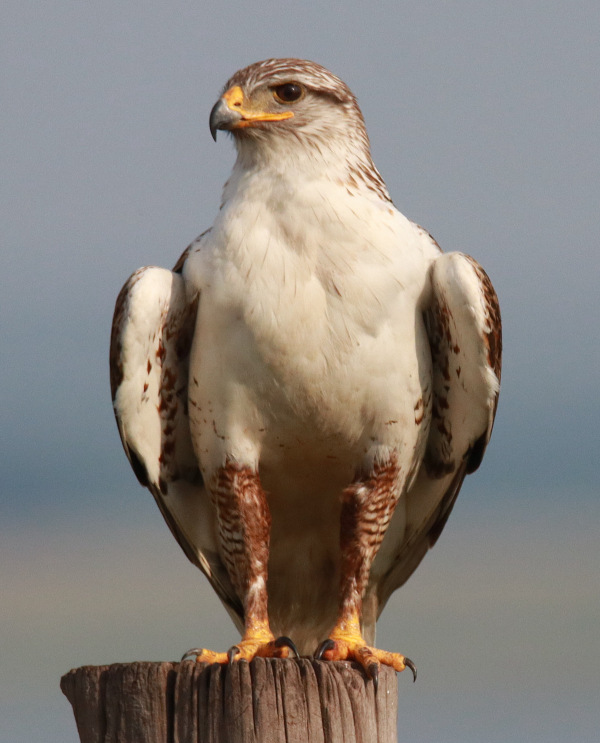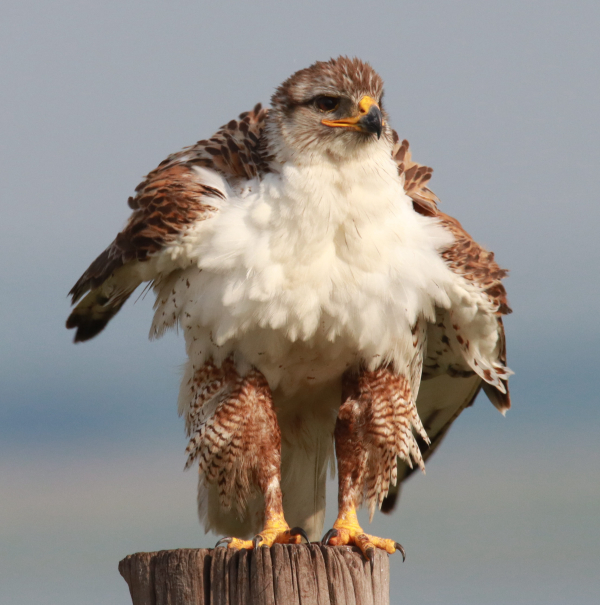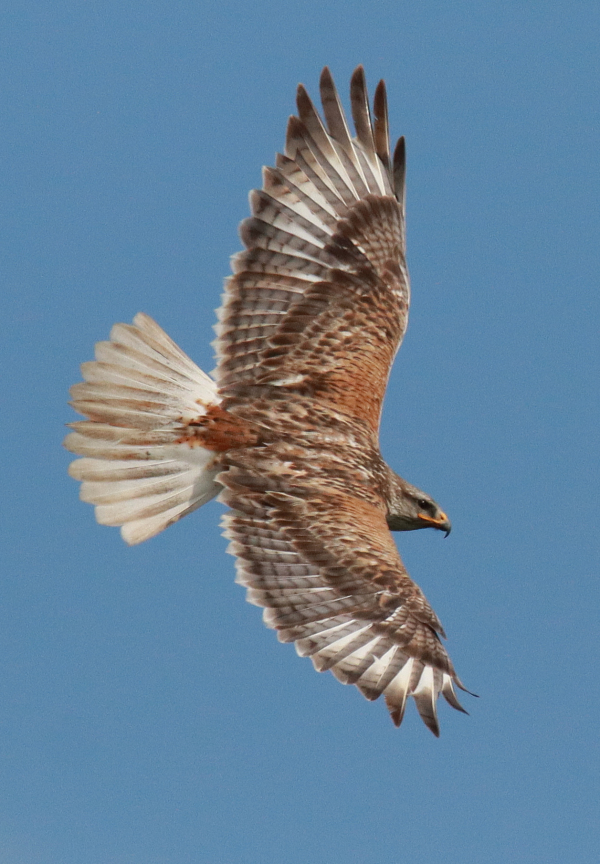
The scientific name of Ferruginous Hawks is “regalis,” and this photo shows how truly regal these large prairie hawks can be (600mm zoom lens, f-8 aperture, 1/1600 shutter speed, 800 ISO).

This photo was taken less than a minute after the above image and shows the climax of a particularly exuberant ruffling motion, stopped in sharp suspension by the camera’s super-fast 1/4000 shutter speed (600mm zoom lens, f-6 aperture, 1/4000 shutter speed, 800 ISO).

A favorite flight photograph has all the ingredients to show the grandeur of this impressive hawk in action, again stopped by the fast shutter speed and timed just as the hawk reached the apex of its banking flight (600mm zoom lens, f-8 aperture, 1/4000 shutter speed, 800 ISO).
|
Finding a bird to photograph within camera range is the hard part, and almost any bird will do in most cases; but sometimes you get lucky and come within range of an especially impressive species. Most people don’t encounter Ferruginous Hawks, so to have an impressive female standing on a perch nearby was especially exciting. Seeing a Ferruginous Hawk is one thing, but photographing a Ferrug is quite another prospect. There is no way of sneaking up on these raptors, so to get close enough to take a portrait-style photo becomes a question of whether you can find an individual that is especially trusting.
From quite a distance I could see the big raptor perched on a low fence post, and I knew there was a potential to photograph this adult Ferruginous Hawk as it rested within its nesting territory. The female was perched a quarter-mile from the nest, so there was little chance of concerning the 3 soon-to-fledge nestlings. She was perched close to a very rural, rarely used gravel road that provided a path for me to drive closer, so I paused to consider the potential for a photo opportunity. There was one very big problem to overcome: The big hawk was positioned between me and my light source – the sun. To get into optimum position between the sun and the hawk, I would need to drive past the hawk without disturbing it. With any other hawk, or any other bird for that matter, that would be close to impossible.
To get into appropriate position with the sun behind me and the bird in front of me, I would need to drive my mobile blind (car) past the hawk and stop, turn off the engine, raise my camera, focus on the hawk, and press the camera’s shutter button to get an initial photo; then wait for the hawk to turn its head just right, if it wasn’t already in flight. That’s a big order to hope for, but either way, it would definitely be worth a try. While I didn’t want to disturb the hawk, if it did fly before I could get into position, hawks take flight often during a given day, and if a different vehicle – a truck, tractor, car, or pickup sped by, it would likely react in the same way it would react to my car passing. The difference was that I would stop and try to photograph it.
I double-checked my camera settings, checked the road ahead for any other vehicles or a dust trail that would indicate another vehicle’s approach (there was none); I took a deep breath, and drove forward at a slower, steady speed with the hope that the hawk wouldn’t flush at my approach, as I passed, or as I turned at a bit of an angle and stopped, turning off the sound of the engine at the same time. I made it a point not to look at the bird as I approached or passed by it, and was pleased to see the big female didn’t flinch. With the hawk showing no momentary concern, I began taking photographs, as she continued to face into the 6pm sunlight, turning her head left, then forward, then right. I was so happy to see this big Ferruginous Hawk so at ease with my white car parked momentarily at relatively close range, especially with her clearly magnified in my camera lens – what more could I ask for?
I checked my LCD screen on the back of my camera to see how the photographs were turning out, and there were some beautiful, sharp portrait photos, which was a great start. But I always like to get some level of action in a photo or series of photos. At that point, it was simply a matter of spending a little time with the hawk to see what its next move might be, as long as no other vehicles appeared on the quiet gravel road that I could scan for a mile in each direction. About that time, as I watched the hawk through my camera lens, it leaned forward slightly and erupted into a wild ruffling movement, seemingly shaking every feather on its body simultaneously – fast action indeed.
Ruffling is pretty basic maintenance behavior for birds, often a part of regular feather preening; but it can also be a precursor to taking flight. This is especially true for birds of prey at rest. In anticipation for taking flight, they often ruffle their feathers, then spread their wings and tail feathers as they launch into flight. On alert, I watched through my camera lens in case the hawk took off, which might offer another level of action to photograph; but the hawk seemed to settle back into its resting stance again. About a minute later, the hawk suddenly pivoted on the top of the post and took flight, gliding low toward its nest and nestlings, but landing in an adjacent tree. I followed the hawk within my camera lens as best I could, but not good enough as I didn’t get a quick focus on the raptor’s flight and managed not one photo.
Oh well, I did what I could. Even so, this was an opportunity for me to emphasize one of the photographs of the ruffling hawk, so very different from its regal pose when at rest. Actually, as common as the ruffling behavior is, we see very few photos of birds engaged in ruffling; photographers don’t tend to select them for publication, nor do editors. But bird behavior is very interesting, and photographing with a still camera can often provide an engaging image, as in this case, especially when compared with the regal portrait photo of this especially trusting prairie hawk.
A Favorite Flight Foto
To make a long story short (often hard for me to do), I continued to check on the Ferruginous Hawk nest site periodically to monitor the progress of the fledglings during the post-fledging period. Last Saturday evening, a week after taking the resting and ruffling photographs, I could see 2 of the young hawks in the nest, with a large adult perched on a tall pole near the rural gravel road. That’s when my photography senses kicked in and I saw this as another photo opportunity, but needed to drive past the hawk again, with success. After taking a couple initial photographs of the same perched female, I saw a motion in the side-view mirror of my car and turned to see what it was – a fledgling!
The young hawk was flying well, already winging a quarter-mile from the nest and headed farther north on strong wingbeats. I tried to take a couple flight photos as it approached a haybale to perch, which were interesting, but not sharp enough to publish. And that’s when the adult female took flight. I needed to escape my car to try to take flight photos of the mighty Ferruginous Hawk, and with the fledgling nearby, the hawk’s demeanor changed to one of a defensive parent – understandably, but a bit surprising; I thought we were buddies, ha-ha.
With the big hawk beginning to circle before me, illuminated beautifully by the western sunlight, when she began banking a second time I took a series of photographs of her flight. In the very middle of the sequence – Bingo – I managed one of my favorite hawk photos of all time, which I share above! I wish you Good Luck in all your birding activities, especially when you are photographing birds.
Article and Photographs by Paul Konrad
Share your bird photos and birding experiences at editorstbw2@gmail.com